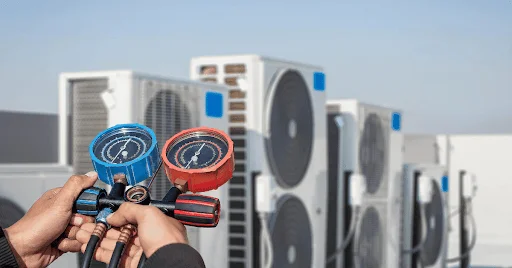Houston’s extreme heat, high humidity, and fluctuating weather make HVAC systems in warehouses work harder than in many other cities. These conditions can quickly drive up energy use and operational costs if your system isn’t designed and managed efficiently. The good news is that expert strategies can help you save energy while keeping your warehouse comfortable and safe. Companies like Texas Central Air specialize in implementing these solutions for commercial spaces, ensuring HVAC systems run efficiently even under Houston’s challenging climate.
In this guide, we break down why warehouse HVAC systems consume so much energy in Houston and provide practical, expert-backed strategies to reduce consumption, lower bills, and maintain optimal system performance.
Why Houston Warehouses Use So Much Energy
Warehouses in Houston face unique HVAC challenges due to a combination of climate, building design, and operational factors.
Houston’s Climate
Houston has a subtropical climate with long, hot summers (peaking around 95°F), high humidity, and mild winters. HVAC systems must handle both heat and moisture, which increases runtime and energy use. On average, energy consumption in Houston warehouses can be 50–60% higher than in drier regions.
Large Spaces and High Ceilings
Many warehouses have ceilings between 20 and 40 feet. Heat naturally rises, creating layers of warm air near the ceiling while cooler air stays lower. Without destratification fans or zoning systems, HVAC units work harder to condition the air, leading to wasted energy and higher bills.
Poor Insulation and Constant Exposure
Warehouses are often built with metal walls, lightweight materials, and large roll-up doors. Frequent opening of these doors exposes conditioned air to the hot, humid outdoors, further increasing HVAC workload. Up to 30% of energy in commercial buildings is lost due to air leaks and inadequate insulation.
Urban Heat Island Effect
Houston’s commercial growth contributes to localized temperature increases, sometimes 1–7°F higher during the day and 2–5°F higher at night. This effect adds to the cooling demand and overall energy use in warehouses.
Common Energy-Wasting Mistakes in Houston Warehouses
Even with a modern HVAC system, many warehouses lose energy unnecessarily because of avoidable mistakes. Understanding these common pitfalls helps you see why strategic upgrades matter:
Leaving large doors open: Every time a loading dock or roll-up door stays open, hot, humid air enters the warehouse, forcing HVAC systems to work harder.
Overcooling empty areas: Cooling unoccupied zones wastes energy. Without zoning or automation, energy is spent unnecessarily.
Ignoring insulation or leaks: Gaps in walls, ceilings, ducts, or around doors allow conditioned air to escape, making the HVAC system run longer.
Neglecting maintenance: Dusty filters, dirty coils, and worn parts reduce efficiency, increasing energy bills and the risk of breakdowns.
By recognizing these mistakes, warehouse managers can target strategies that prevent wasted energy and improve system performance.
Expert Strategies to Save Energy in Houston Warehouses
Warehouses in Houston face unique challenges due to large spaces, high ceilings, and the city’s hot, humid climate. Without the right approach, HVAC systems can consume excessive energy and increase operational costs. The following strategies focus on practical, high-impact ways to improve efficiency, reduce energy bills, and keep your warehouse comfortable year-round.
Upgrade to High-Efficiency Systems
High-efficiency HVAC systems use less energy to cool the same space. For warehouses, systems with a SEER2 rating of 14.3 or higher are recommended, with 16+ ratings providing superior performance. Look for variable-speed blowers and compressors to adjust output based on demand, reducing unnecessary energy use.
Use Destratification Fans
Warm air rises to the ceiling, leaving lower levels cooler. Destratification fans push the warm air back down, reducing HVAC runtime by up to 30% and saving significant energy.
Install Smart Thermostats and Automation
Smart thermostats adjust temperature automatically based on occupancy, reducing energy waste in unoccupied areas. Combined with building automation, they allow remote control of HVAC settings and can save 10–23% on energy consumption.
Implement Zoning
Dividing a warehouse into separate zones based on occupancy or storage needs allows targeted heating and cooling. HVAC systems only run where needed, reducing energy waste.
Schedule Bi-Annual Maintenance
Routine maintenance keeps systems running efficiently, addresses small issues before they become costly, and prepares units for seasonal weather changes. Well-maintained systems can improve efficiency by up to 25%.
Improve Sealing and Insulation
Prevent conditioned air from escaping through poorly insulated walls, roofs, ducts, doors, and windows. Consider reflective or cool roofing, insulated ceilings and walls, duct sealing, and weatherstripping high-traffic openings. Reflective roofs alone can reduce roof surface temperatures by up to 50°F.
4 Additional Tactics Often Overlooked
Even after installing high-efficiency systems and smart controls, there are simple, often-missed actions that can make a big difference in energy savings and warehouse comfort. These small adjustments are easy to implement and can have immediate benefits.1
1. Adjust Thermostats in Non-Critical Areas
After working hours, set the thermostats in sections of the warehouse that aren’t actively used to around 85°F. This prevents the HVAC system from overcooling empty spaces, reducing energy use by 10–20% without affecting stored goods or operations.
2. Take Advantage of Outdoor Air
Some HVAC systems can pull cooler outdoor air into the warehouse when conditions allow, reducing the need for mechanical cooling. This “free cooling” approach saves energy while keeping temperatures comfortable, especially during mild evenings or early mornings.
3. Monitor Energy in Real Time
Using energy-monitoring tools helps track how much electricity your HVAC system is using at any given time. By spotting patterns of excessive energy use, managers can make quick adjustments like changing thermostat settings or checking for air leaks before they become costly problems.
4. Keep Air Circulating Efficiently
Destratification fans help push warm air from the ceiling down to working areas. Keeping these fans running consistently ensures the warehouse stays evenly heated or cooled, reducing the workload on the HVAC system and preventing hot or cold spots that can waste energy.
By combining these simple tactics with the main expert strategies like high-efficiency systems, zoning, and regular maintenance, Houston warehouse operators can save energy, reduce bills, and maintain a comfortable, safe environment for workers and stored products.
Final Thoughts
Houston’s hot, humid climate and the size of warehouse spaces make energy-efficient HVAC systems essential. Following expert strategies like high-efficiency systems, destratification fans, smart thermostats, zoning, and regular maintenance can reduce energy use, lower bills, and extend system life.
Partnering with experienced providers like Texas Central Air and trusted commercial HVAC services in Houston, TX, ensures these strategies are implemented effectively, helping your warehouse operate efficiently and sustainably throughout the year.


